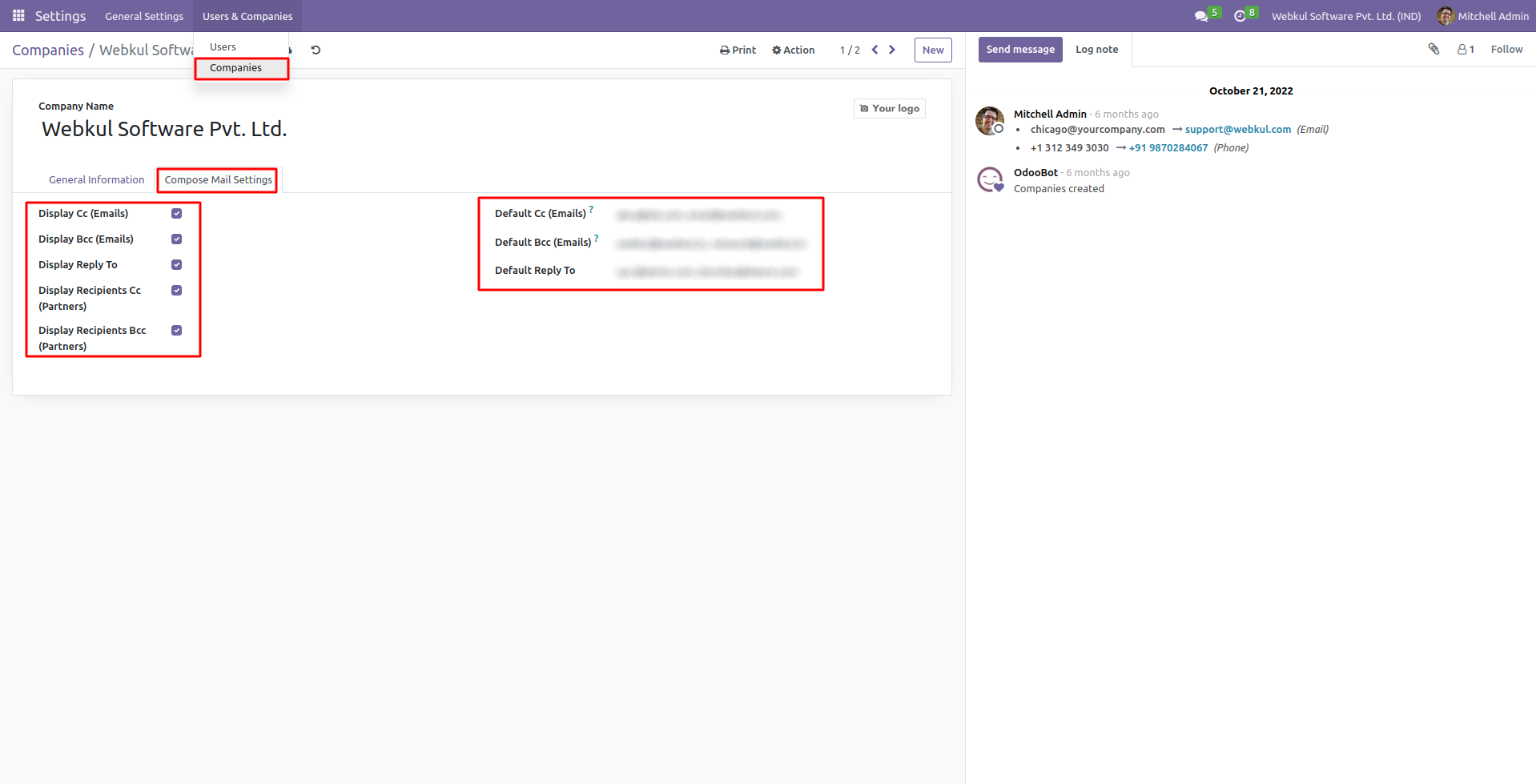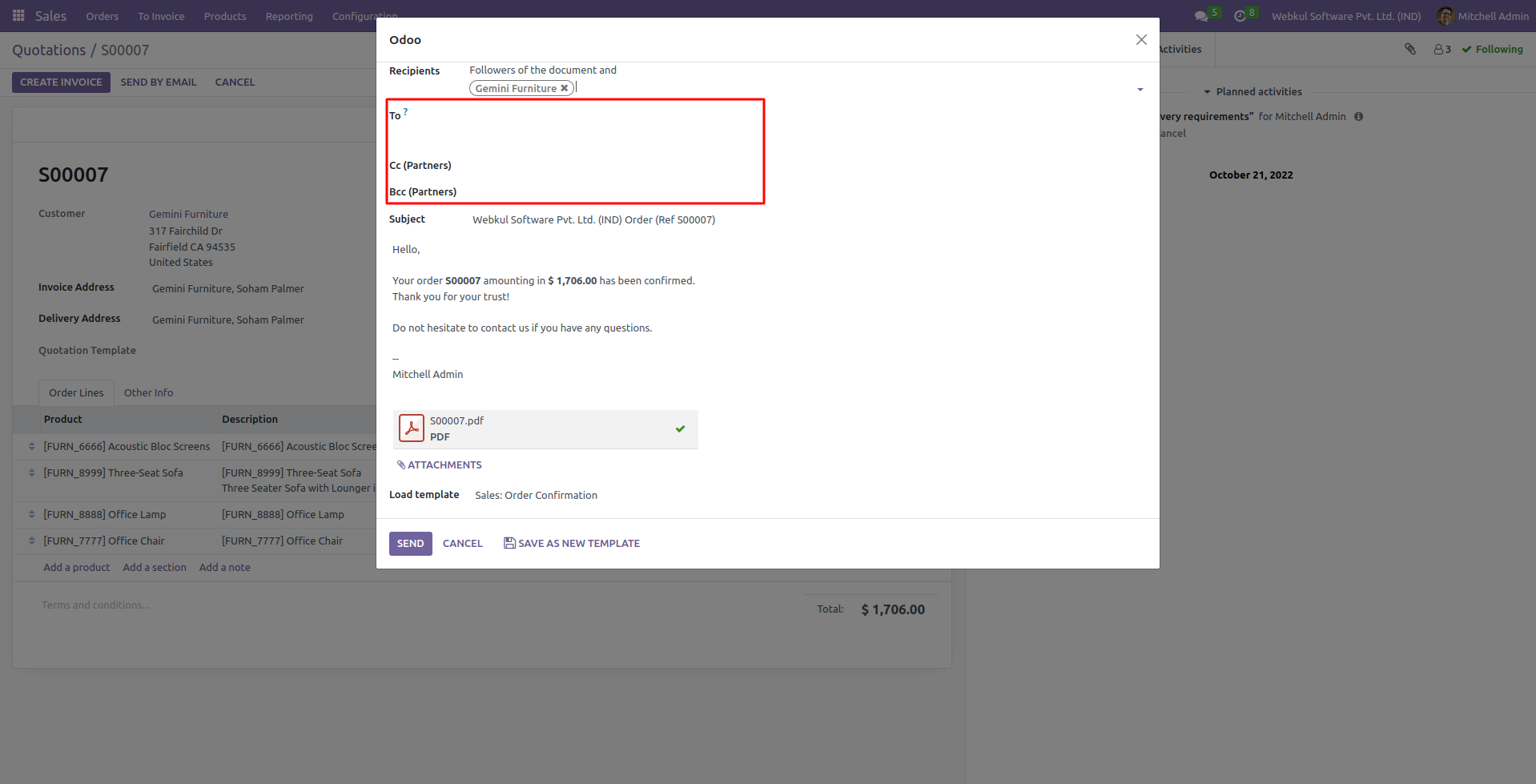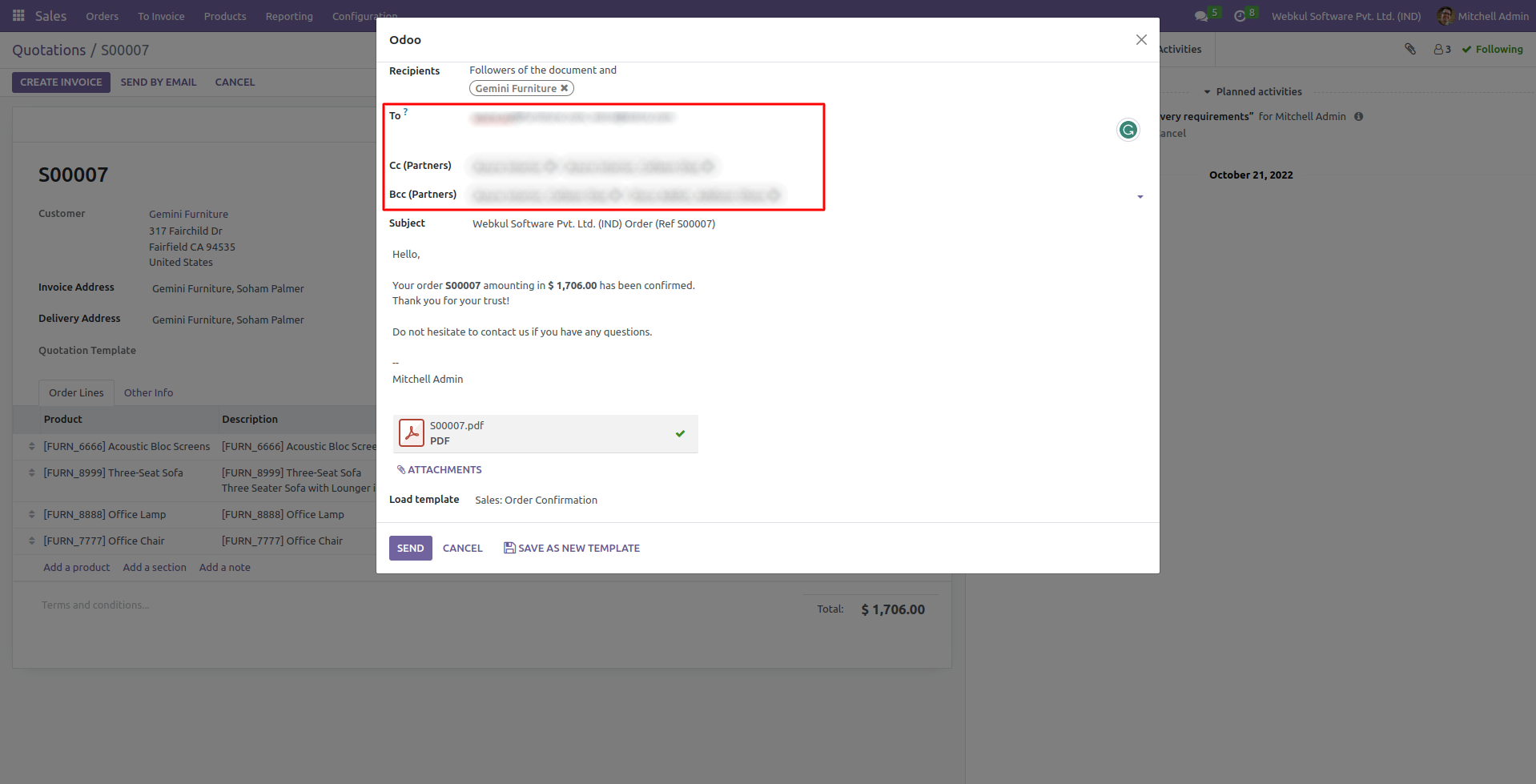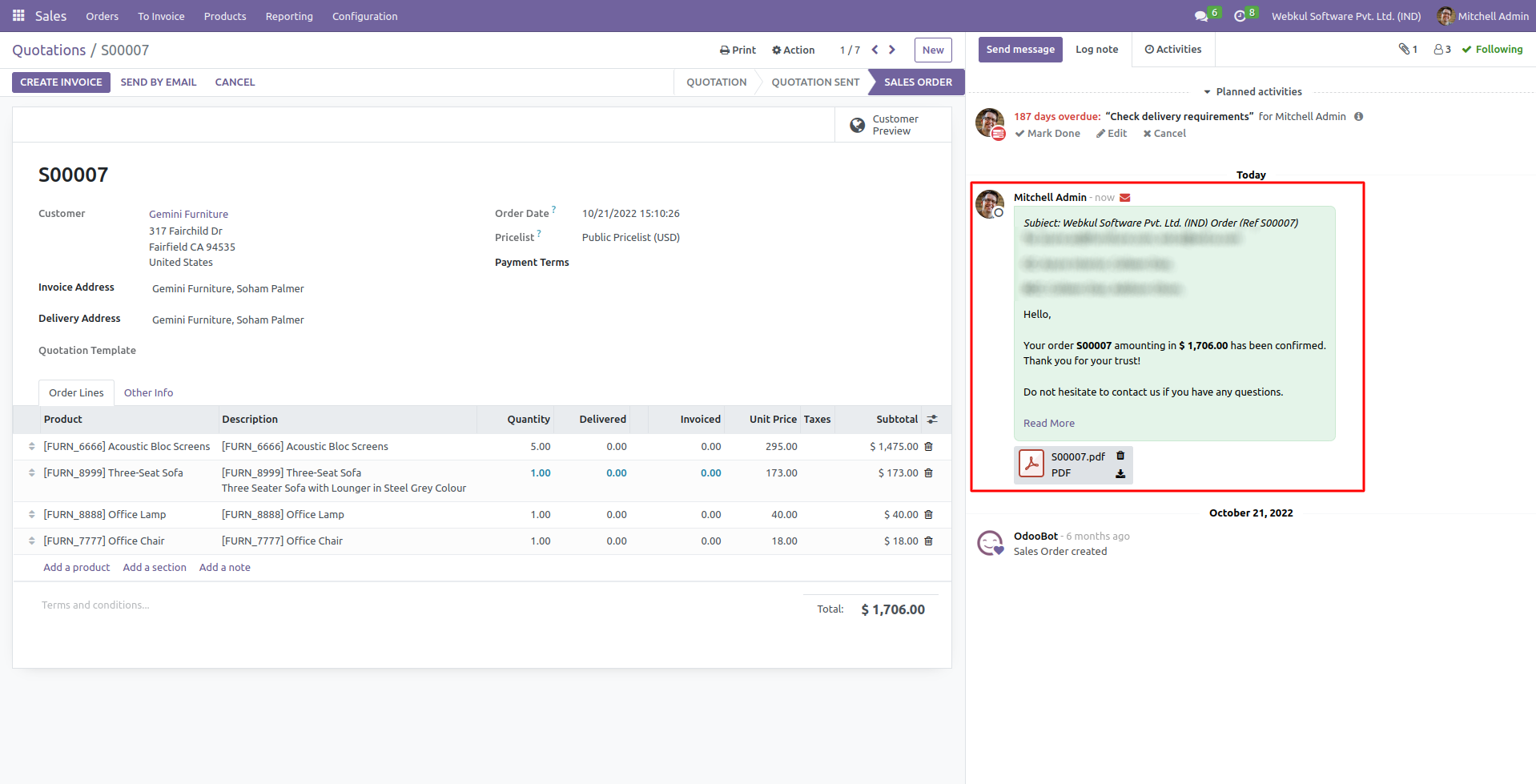- APPS
- ODOO Email CC and BCC 17.0
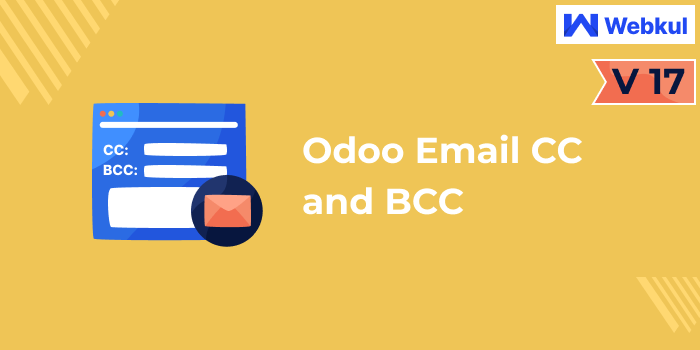
ODOO Email CC and BCC
| Technical name | odoo_email_cc_bcc |
| License | LGPL-3 |
| Website | https://store.webkul.com/Odoo-Email-CC-and-BCC.html |
Odoo Email CC and BCC
Track all correspondences transpiring in Odoo!
Odoo Email CC and BCC permit you to include any email address apart from included ones in the CC and BCC field while composing an email. It further adds a CC and BCC field to enter the desired single or multiple email addresses and send the mail.
Information
What are CC and BCC emails?
Email CC or Carbon Copy means that an email address added in the CC section also receives a copy of the mail. All received a CC mail. It helps you to make everybody aware of the mail trail communication without any ambiguity.
Contrarily, BCC or Blind Carbon Copy is somewhat similar to CC but the only difference is that the BCC recipients names are hidden from the other email recipients.
Hence, Odoo Email CC and BCC let you manage emails hassle-freely. The Odoo app facilitates you to include any email address and not just partners in CC and BCC field while composing emails in Odoo.
It adds a CC and BCC field to enter the desired single or multiple email addresses and send the mail.
Manage Email CC and BCC in Odoo without Hassle!
Odoo offers solutions for almost every business problem. However, there is room for improvement and we improved the mailing system by adding the functionality of CC and BCC in Odoo.
The Odoo admin can set default email addresses for CC and BCC to appear automatically in the emails. Moreover, it provides the user with a Reply-To field to enter the email address of the correspondent if the recipient needs to reply to the sender.
In addition, it makes the conversations trackable for everyone and avoids future ambiguity.
Benefits of Email CC and BCC
Both emails have their own benefits which can be used accordingly.
- CC mail can be used when the information is useful and you need to update team members regarding the same.
- Also, CC mail helps you emphasize the urgency of a task, project, or any other work.
- Use the CC mail to introduce people.
- Use BCC mail while communicating with customers.
- Further, the BCC mail can be used to add many recipients.
- Do use BCC for an impersonal email containing generic messages for the recipients.
Highlighted Features
Below is the highlighted list of features for Odoo Email CC BCC
Add CC and BCC fields in the mail
Keep track of all correspondences
Keep desired mail in the fields along with partners
Add a Reply-To option to enter custom emails
Set default CC and BCC emails
Automatically shows default CC and BCC email
- Screenshots
- Detailed Features
Detailed Features List
Below is the detailed list of Feature for Odoo Email CC BCC
Track all of the Emails in Odoo
- The Odoo app permits the user to track all the correspondences in Odoo.
- The user can add any email address in the CC and BCC field in Odoo in addition to the partners.
- Users can further add a Reply-To field to enter a custom email address of the correspondent for the recipients use.
Specify Default Email Address to CC and BCC
- You can set a default email address to CC and BCC fields, which would appear automatically in the respective field while composing mail.
- kewise, a default email address can also be added to the Reply To field to be used automatically in the emails.
Help and Support
Get Immediate support for any of your query
You will get 90 days free support for any doubt, queries, and bug fixing (excluding data recovery) or any type of issue related to this module.

Write a mail to us:
[email protected]Any queries or want any extra features? Just drop a mail to our support.
Get in touch with our Expert:
https://webkul.uvdesk.com/en/customer/create-ticket/Any technical queries, want extra features, or anything else, our team is ready to answer all your questions, just raise a support ticket.
This is an unofficial translation of the GNU Lesser General Public License into Vietnamese. It was not published by the Free Software Foundation,
and does not legally state the distribution terms for software that uses the GNU LGPL - only the original English text of the GNU LGPL does
that. However, we hope that this translation will help language speakers understand the GNU LGPL better.
GNU LESSER GENERAL PUBLIC LICENSE
Version 3, 29 June
2007
Copyright (C) 2007 Free Software Foundation, Inc. <https://fsf.org/>
Everyone is permitted to copy and distribute verbatim copies of this license document, but changing it is not allowed.
This version of the GNU Lesser General Public License incorporates the terms and conditions of version 3 of the GNU General Public License,
supplemented by the additional permissions listed below.
0. Additional Definitions.
As used herein,"this License" refers to version 3 of the GNU Lesser General Public License, and the "GNU GPL" refers to version 3 of
the GNU "General" Public License.
"The Library" refers to a covered work governed by this License, other than an Application or a Combined Work as defined below.
An "Application" is any work that makes use of an interface provided by the Library, but which is not otherwise based on the Library.
Defining a subclass of a class defined by the Library is deemed a mode of using an interface provided by the Library.
A "Combined Work" is a work produced by combining or linking an Application with the Library. The particular version of the Library
with which the Combined Work was made is also called the "Linked Version".
The "Minimal Corresponding Source" for a Combined Work means the Corresponding Source for the Combined Work, excluding any source code
for portions of the Combined Work that, considered in isolation, are based on the Application, and not on the Linked Version.
The "Corresponding Application Code" for a Combined Work means the object code and/or source code for the Application, including any data
and utility programs needed for reproducing the Combined Work from the Application, but excluding the System Libraries of the Combined Work.
1. Exception to Section 3 of the GNU GPL.
You may convey a covered work under sections 3 and 4 of this License without being bound by section 3 of the GNU GPL.
2. Conveying Modified Versions.
If you modify a copy of the Library, and, in your modifications, a facility refers to a function or data to be supplied by an Application that
uses the facility (other than as an argument passed when the facility is invoked), then you may convey a copy of the modified version:
a) under this License, provided that you make a good faith effort to ensure that, in the event an Application does not supply the function or data, the facility still
operates, and performs whatever part of its purpose remains meaningful, or
b) under the GNU GPL, with none of the additional permissions of this License applicable to that copy.
3. Object Code Incorporating Material from Library Header Files.
The object code form of an Application may incorporate material from a header file that is part of the Library. You may convey such
object code under terms of your choice, provided that, if the incorporated material is not limited to numerical parameters, data structure
layouts and accessors, or small macros, inline functions and templates (ten or fewer lines in length), you do both of the following:
a) Give prominent notice with each copy of the object code that the Library is used in it and that the Library and its use are covered by this License.
b) Accompany the object code with a copy of the GNU GPL and this license document.
4. Combined Works.
You may convey a Combined Work under terms of your choice that, taken together, effectively do not restrict modification of the portions of the
Library contained in the Combined Work and reverse engineering for debugging such modifications, if you also do each of the following:
a) Give prominent notice with each copy of the Combined Work that the Library is used in it and that the Library and its use are covered by this License.
b) Accompany the Combined Work with a copy of the GNU GPL and this license document.
c) For a Combined Work that displays copyright notices during execution, include the copyright notice for the Library among these notices,
as well as a reference directing the user to the copies of the GNU GPL and this license document.
d) Do one of the following:
0) Convey the Minimal Corresponding Source under the terms of this License, and the Corresponding Application Code in a form suitable for, and
under terms that permit, the user to recombine or relink the Application with a modified version of the Linked Version to produce a modified
Combined Work, in the manner specified by section 6 of the GNU GPL for conveying Corresponding Source.
1) Use a suitable shared library mechanism for linking with the Library. A suitable mechanism is one that (a) uses at run time a copy of the
Library already present on the user's computer system, and (b) will operate properly with a modified version of the Library
that is interface-compatible with the Linked Version.
e) Provide Installation Information, but only if you would otherwise be required to provide such information under section 6 of the
GNU GPL, and only to the extent that such information is necessary to install and execute a modified version of the Combined Work produced by
recombining or relinking the Application with a modified version of the Linked Version. (If you use option 4d0, the Installation Information
must accompany the Minimal Corresponding Source and Corresponding Application Code. If you use option 4d1, you must provide the Installation
Information in the manner specified by section 6 of the GNU GPL for conveying Corresponding Source.)
5. Combined Libraries.
You may place library facilities that are a work based on the Library side by side in a single library together with other library facilities that
are not Applications and are not covered by this License, and convey such a combined library under terms of your choice, if you do both of
the following:
a)Accompany the combined library with a copy of the same work based on the Library, uncombined with any other library facilities,
conveyed under the terms of this License.
b) Give prominent notice with the combined library that part of it is a work based on the Library, and explaining where to find the accompanying
uncombined form of the same work.
6. Revised Versions of the GNU Lesser General Public License.
The Free Software Foundation may publish revised and/or new versions of the GNU Lesser General Public License from time to time. Such new
versions will be similar in spirit to the present version, but may differ in detail to address new problems or concerns.
Each version is given a distinguishing version number. If the Library as you received it specifies that a certain numbered
version of the GNU Lesser General Public License "or any later version" applies to it, you have the option of following the terms and
conditions either of that published version or of any later version published by the Free Software Foundation. If the Library as you
received it does not specify a version number of the GNU Lesser General Public License, you may choose any version of the GNU Lesser
General Public License ever published by the Free Software Foundation.
If the Library as you received it specifies that a proxy can decide whether future versions of the GNU Lesser General Public License shall
apply, that proxy's public statement of acceptance of any version is permanent authorization for you to choose that version for the Library.
